

AlphaLISA SureFire Ultra Human and Mouse Phospho-ERK1/2 (Thr202/Tyr204) Detection Kit, 100 Assay Points
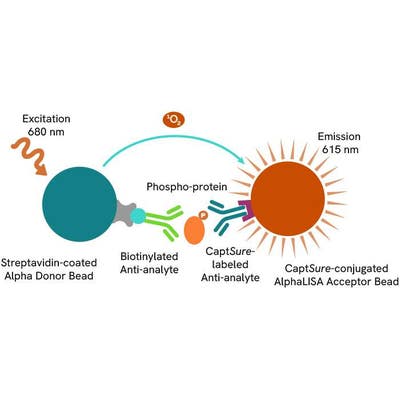
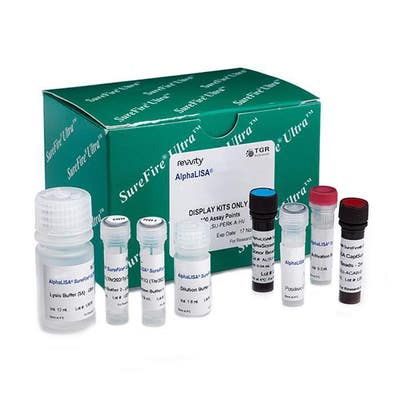
 View All
View All
AlphaLISA SureFire Ultra Human and Mouse Phospho-ERK1/2 (Thr202/Tyr204) Detection Kit, 100 Assay Points
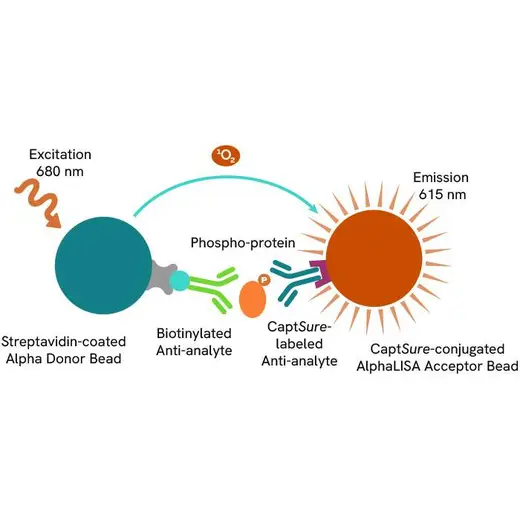
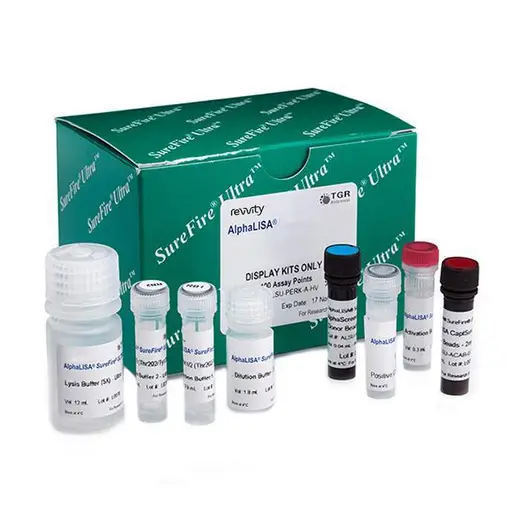




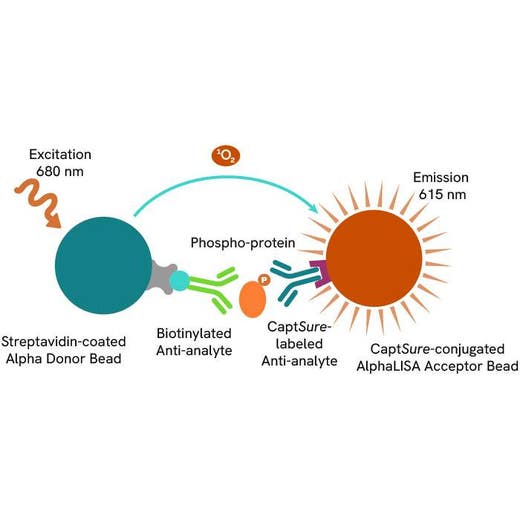





The AlphaLISA™ SureFire® Ultra™ p-ERK 1/2 (Thr202/Tyr204) assay is a sandwich immunoassay for quantitative detection of phospho-ERK 1/2 (phosphorylated on Thr202/Tyr204 in ERK1, or Thr185/Tyr187 in ERK2) in cellular lysates using Alpha Technology.
| Feature | Specification |
|---|---|
| Application | Cell Signaling |
| Sample Volume | 30 µL |
The AlphaLISA™ SureFire® Ultra™ p-ERK 1/2 (Thr202/Tyr204) assay is a sandwich immunoassay for quantitative detection of phospho-ERK 1/2 (phosphorylated on Thr202/Tyr204 in ERK1, or Thr185/Tyr187 in ERK2) in cellular lysates using Alpha Technology.






AlphaLISA SureFire Ultra Human and Mouse Phospho-ERK1/2 (Thr202/Tyr204) Detection Kit, 100 Assay Points






AlphaLISA SureFire Ultra Human and Mouse Phospho-ERK1/2 (Thr202/Tyr204) Detection Kit, 100 Assay Points






Loading...
Product information
Overview
ERK1/2 (Extracellular Signal-Regulated Kinases 1 and 2), also known as MAPK3 and MAPK1 respectively, are crucial components of the MAPK/ERK signaling pathway in both humans and mice. These kinases play central roles in various cellular processes, including cell proliferation, differentiation, survival, and migration. Activation of ERK1/2 occurs through dual phosphorylation at specific threonine and tyrosine residues (Thr202/Tyr204 for human ERK1; Thr185/Tyr187 for human ERK2), which is essential for their kinase activity and subsequent regulation of downstream targets. The MAPK/ERK pathway is frequently dysregulated in various pathological conditions, particularly in cancer, developmental disorders, and neurodegenerative diseases. Aberrant activation of ERK1/2 can contribute to uncontrolled cell proliferation, resistance to apoptosis, and enhanced cell survival, often associated with tumor progression and therapy resistance. Conversely, insufficient ERK1/2 activation can lead to developmental abnormalities and impaired cellular responses to growth factors and other stimuli.
The AlphaLISA SureFire Ultra Human and Mouse Phospho-ERK1/2 (Thr202/Tyr204) Detection Kit is a sandwich immunoassay designed for the quantitative detection of phosphorylated ERK1/2 in cellular lysates from both human and mouse samples using Alpha technology.
Formats:
- The HV (high volume) kit contains reagents to run 100 wells in 96-well format, using a 60 μL reaction volume.
- The 500-point kit contains enough reagents to run 500 wells in 384-well format, using a 20 μL reaction volume.
- The 10,000-point kit contains enough reagents to run 10,000 wells in 384-well format, using a 20 μL reaction volume.
- The 50,000-point kit contains enough reagents to run 50,000 wells in 384-well format, using a 20 μL reaction volume.
AlphaLISA SureFire Ultra kits are compatible with:
- Cell and tissue lysates
- Antibody modulators
- Biotherapeutic antibodies
Alpha SureFire kits can be used for:
- Cellular kinase assays
- Receptor activation studies
- Screening
How it works
Phospho-AlphaLISA SureFire Ultra assay principle
The Phospho-AlphaLISA SureFire Ultra assay measures a protein target when phosphorylated at a specific residue.
The assay uses two antibodies which recognize the phospho epitope and a distal epitope on the targeted protein. AlphaLISA assays require two bead types: Acceptor and Donor beads. Acceptor beads are coated with a proprietary CaptSure™ agent to specifically immobilize the assay specific antibody, labeled with a CaptSure™ tag. Donor beads are coated with streptavidin to capture one of the detection antibodies, which is biotinylated. In the presence of phosphorylated protein, the two antibodies bring the Donor and Acceptor beads in close proximity whereby the singlet oxygen transfers energy to excite the Acceptor bead, allowing the generation of a luminescent Alpha signal. The amount of light emission is directly proportional to the quantity of phosphoprotein present in the sample.

Phospho-AlphaLISA SureFire Ultra two-plate assay protocol
The two-plate protocol involves culturing and treating the cells in a 96-well plate before lysis, then transferring lysates into a 384-well OptiPlate™ plate before the addition of Phospho-AlphaLISA SureFire Ultra detection reagents. This protocol permits the cells' viability and confluence to be monitored. In addition, lysates from a single well can be used to measure multiple targets.
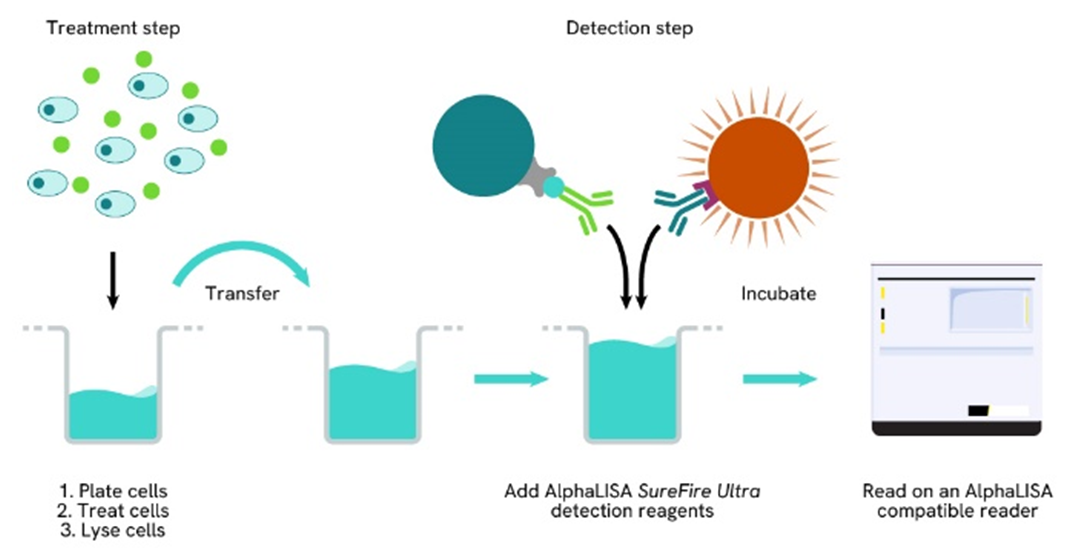
Phospho-AlphaLISA SureFire Ultra one-plate assay protocol
Detection of Phosphorylated target protein with AlphaLISA SureFire Ultra reagents can be performed in a single plate used for culturing, treatment, and lysis. No washing steps are required. This HTS designed protocol allows for miniaturization while maintaining AlphaLISA SureFire Ultra quality.
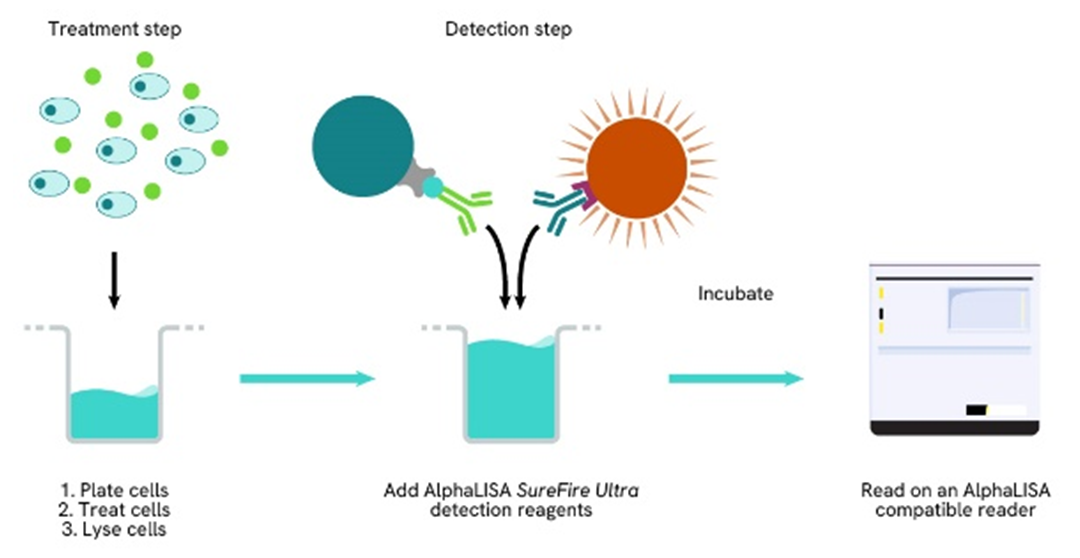
Assay validation
Induction of ERK1/2 (Thr202/Tyr204) phosphorylation in primary cells
PBMCs were isolated from healthy donors using Ficoll Plaque Plus (Merck, GE17-1440-02), Cells were seeded in a 96-well plate (400,000 cells/well) in complete DMEM and treated with the indicated agonists for 30 minutes.
After treatment, the cells were lysed with 400 µL of Lysis Buffer for 10 minutes at RT with shaking (350 rpm). ERK1/2 Phospho (Thr202/Tyr204) levels were evaluated using the AlphaLISA SureFire Ultra assay. For the detection step, 10 µL of cell lysate (approximately 10,000 cells) was transferred into a 384-well white OptiPlate, followed by 5 µL of Acceptor mix and incubated for 1 hour at RT. Finally, 5 µL of Donor mix was then added to each well and incubated for 1 hour at RT in the dark. The plate was read on an Envision using standard AlphaLISA settings.
As expected, ERK phosphorylation was induced by PMA and LPS in PBMCs.
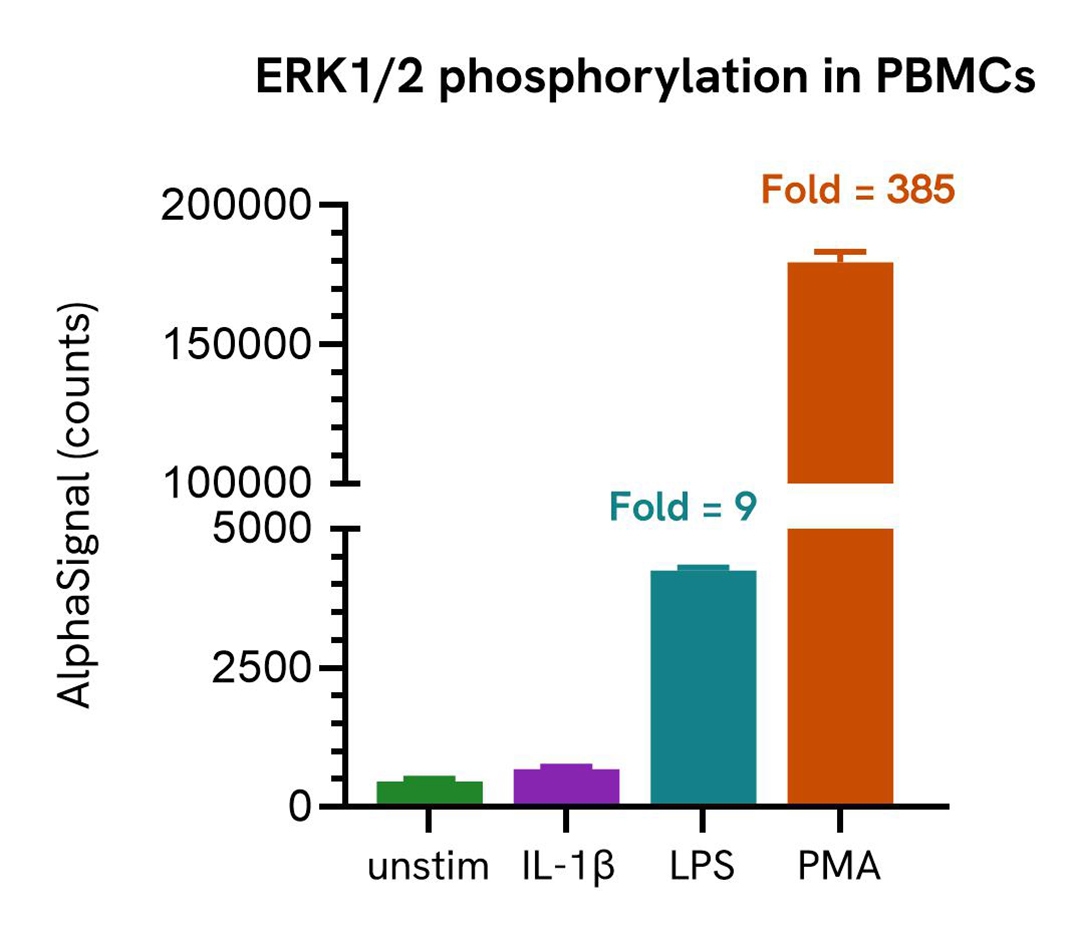
Activation of Phospho ERK1/2 (Thr202/Tyr204) in Anti-CD3 treated cells
Jurkat cells were seeded in a 96-well plate (50,000 cells/well) in HBSS + 0.1% BSA. The cells were starved for 60 minutes and then treated with increasing concentrations of Anti-CD3 antibody for 5 minutes.
After treatment, the cells were lysed with the addition of 50 µL of 5X Lysis Buffer for 10 minutes at RT with shaking (350 rpm). ERK1/2 Phospho (Thr202/Tyr204) and Total levels were evaluated using respective AlphaLISA SureFire Ultra assays. For the detection step, 10 µL of cell lysate (approximately 2,000 cells) was transferred into a 384-well white OptiPlate, followed by 5 µL of Acceptor mix and incubated for 1 hour at RT. Finally, 5 µL of Donor mix was then added to each well and incubated for 1 hour at RT in the dark. The plate was read on an Envision using standard AlphaLISA settings.
As expected, Anti-CD3 triggered a dose-dependent increase in the levels of Phospho ERK1/2 (Thr202/Tyr204) while Total ERK1/2 levels remained unchanged.
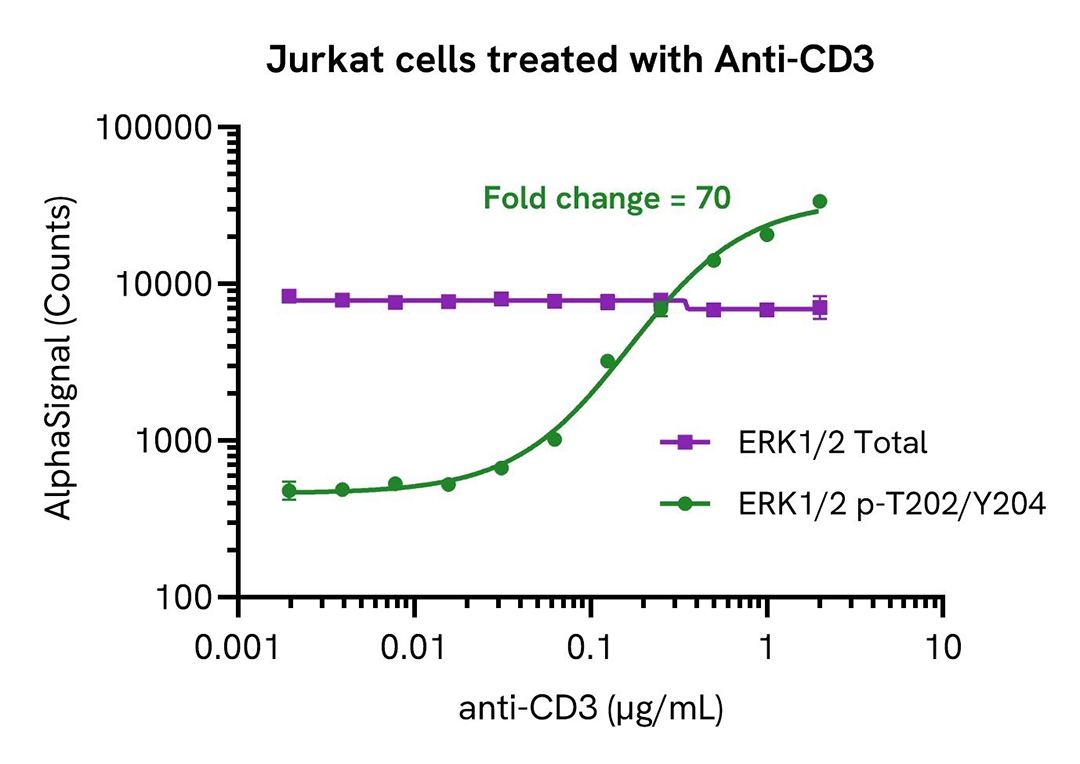
Activation of Phospho ERK1/2 (Thr202/Tyr204) in Neuregulin1 treated cells
MCF7 cells were seeded in a 96-well plate (40,000 cells/well) in complete medium, and incubated overnight at 37°C, 5% CO2. The cells were starved for two hours and then treated with increasing concentrations of Neuregulin1 (NRG1) for 10 minutes.
After treatment, the cells were lysed with 100 µL of Lysis Buffer for 10 minutes at RT with shaking (350 rpm). ERK1/2 Phospho (Thr202/Tyr204) and Total levels were evaluated using respective AlphaLISA SureFire Ultra assays. For the detection step, 10 µL of cell lysate (approximately 4,000 cells) was transferred into a 384-well white OptiPlate, followed by 5 µL of Acceptor mix and incubated for 1 hour at RT. Finally, 5 µL of Donor mix was then added to each well and incubated for 1 hour at RT in the dark. The plate was read on an Envision using standard AlphaLISA settings.
As expected, Neuregulin1 triggered a dose-dependent increase in the levels of Phospho ERK1/2 (Thr202/Tyr204) while Total ERK1/2 levels remained unchanged.
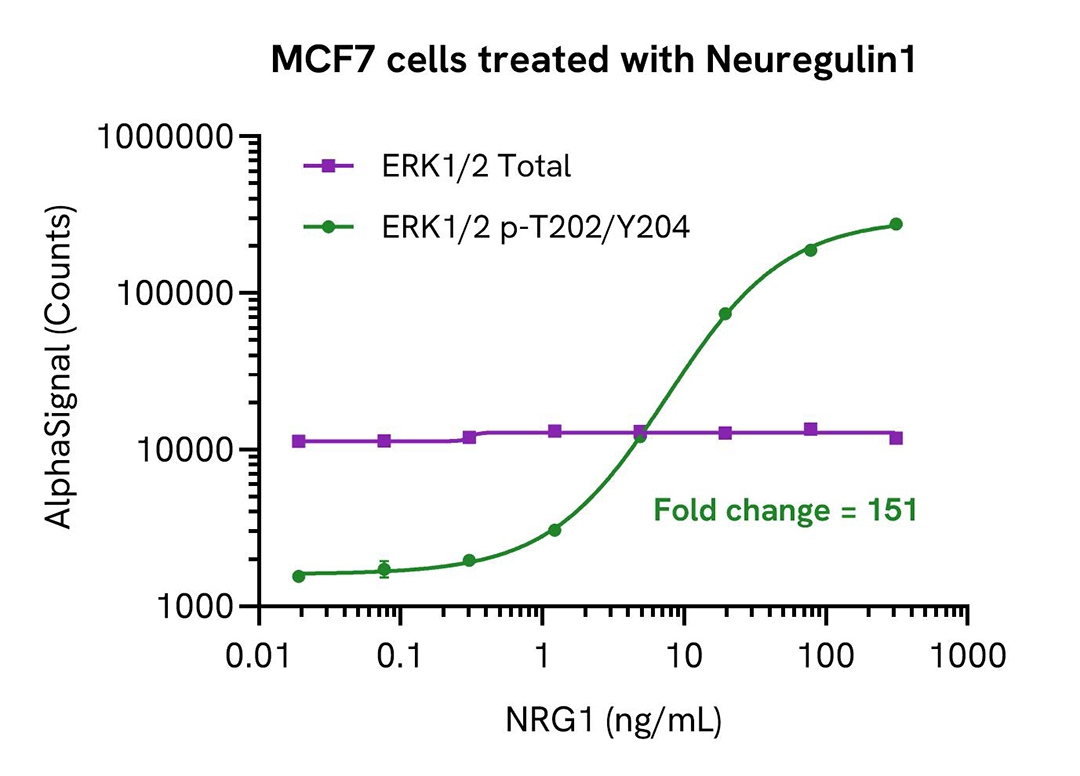
Activation of Phospho ERK1/2 (Thr202/Tyr204) in EGF treated cells
HEK293 cells were seeded in a 96-well plate (40,000 cells/well) in complete medium, and incubated overnight at 37°C, 5% CO2. The cells were starved for two hours and then treated with increasing concentrations of EGF for 30 minutes.
After treatment, the cells were lysed with 100 µL of Lysis Buffer for 10 minutes at RT with shaking (350 rpm). ERK1/2 Phospho (Thr202/Tyr204) and Total levels were evaluated using respective AlphaLISA SureFire Ultra assays. For the detection step, 10 µL of cell lysate (approximately 4,000 cells) was transferred into a 384-well white OptiPlate, followed by 5 µL of Acceptor mix and incubated for 1 hour at RT. Finally, 5 µL of Donor mix was then added to each well and incubated for 1 hour at RT in the dark. The plate was read on an Envision using standard AlphaLISA settings.
As expected, EGF triggered a dose-dependent increase in the levels of Phospho ERK1/2 (Thr202/Tyr204) while Total ERK1/2 levels remained unchanged.
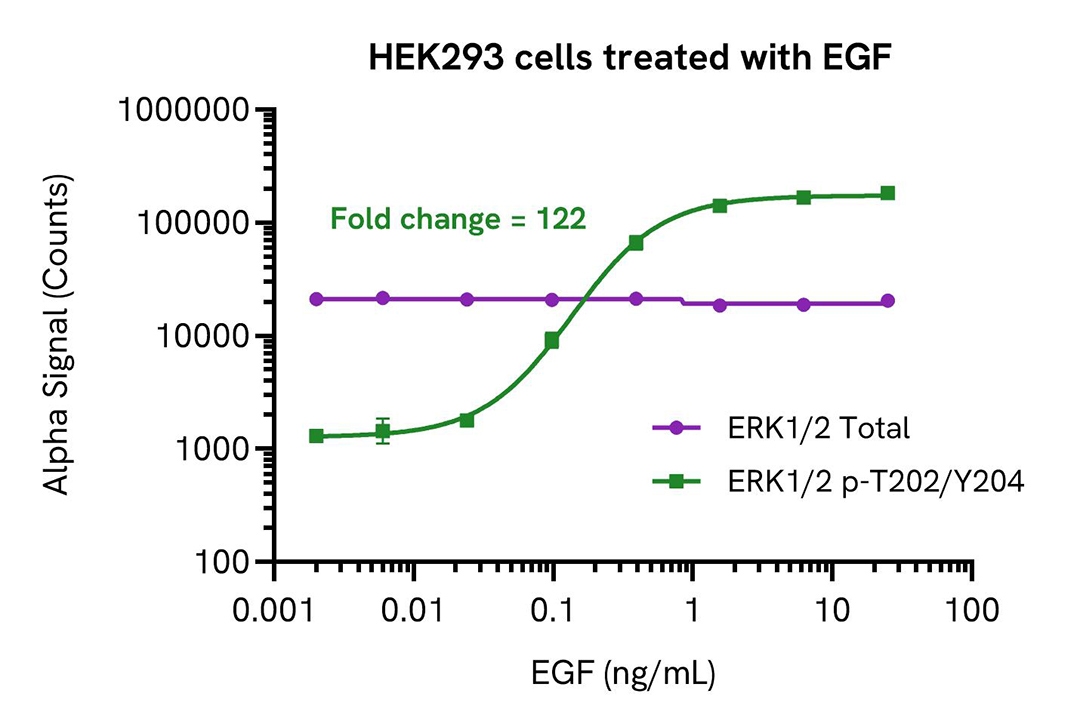
Activation of Phospho ERK1/2 (Thr202/Tyr204) in TNFα treated cells
HeLa cells were seeded in a 96-well plate (40,000 cells/well) in complete medium, and incubated overnight at 37°C, 5% CO2. The cells were treated with increasing concentrations of TNFα for 30 minutes.
After treatment, the cells were lysed with 100 µL of Lysis Buffer for 10 minutes at RT with shaking (350 rpm). ERK1/2 Phospho (Thr202/Tyr204) and Total levels were evaluated using respective AlphaLISA SureFire Ultra assays. For the detection step, 10 µL of cell lysate (approximately 4,000 cells) was transferred into a 384-well white OptiPlate, followed by 5 µL of Acceptor mix and incubated for 1 hour at RT. Finally, 5 µL of Donor mix was then added to each well and incubated for 1 hour at RT in the dark. The plate was read on an Envision using standard AlphaLISA settings.
As expected, TNFα triggered a dose-dependent increase in the levels of Phospho ERK1/2 (Thr202/Tyr204) while Total ERK1/2 levels remained unchanged.

Decrease of Phospho ERK1/2 (Thr202/Tyr204) levels in AG1478 treated cells
HeLa cells were seeded in a 96-well plate (40,000 cells/well) in complete medium, and incubated overnight at 37°C, 5% CO2. The cells were treated with increasing concentrations of AG1478 for 2 hours, and then 1 ng/mL EGF for 30 minutes.
After treatment, the cells were lysed with 100 µL of Lysis Buffer for 10 minutes at RT with shaking (350 rpm). ERK1/2 Phospho (Thr202/Tyr204) and Total levels were evaluated using respective AlphaLISA SureFire Ultra assays. For the detection step, 10 µL of cell lysate (approximately 4,000 cells) was transferred into a 384-well white OptiPlate, followed by 5 µL of Acceptor mix and incubated for 1 hour at RT. Finally, 5 µL of Donor mix was then added to each well and incubated for 1 hour at RT in the dark. The plate was read on an Envision using standard AlphaLISA settings.
As expected, AG1478 triggered a dose-dependent decrease in the levels of Phospho ERK (Thr202/Tyr204) while Total ERK1/2 levels remained unchanged.
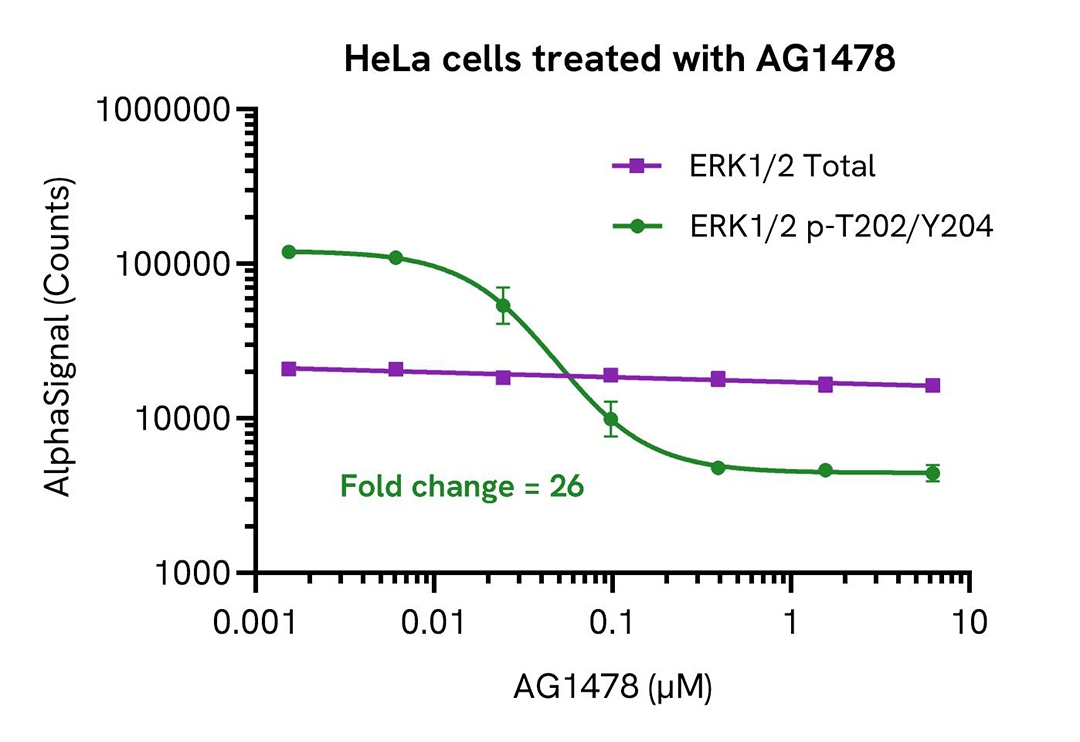
Decrease of Phospho ERK1/2 (Thr202/Tyr204) levels in Oxozeanol treated cells
HEK293 cells were seeded in a 96-well plate (40,000 cells/well) in complete medium, and incubated overnight at 37°C, 5% CO2. The cells were treated with increasing concentrations of Oxozeanol for 2 hours followed by treatment with 0.75M Sorbitol for 30 minutes.
After treatment, the cells were lysed with 100 µL of Lysis Buffer for 10 minutes at RT with shaking (350 rpm). ERK1/2 Phospho (Thr202/Tyr204) and Total levels were evaluated using respective AlphaLISA SureFire Ultra assays. For the detection step, 10 µL of cell lysate (approximately 4,000 cells) was transferred into a 384-well white OptiPlate, followed by 5 µL of Acceptor mix and incubated for 1 hour at RT. Finally, 5 µL of Donor mix was then added to each well and incubated for 1 hour at RT in the dark. The plate was read on an Envision using standard AlphaLISA settings.
As expected, Oxozeanol triggered a dose-dependent decrease in the levels of Phospho ERK (Thr202/Tyr204) while Total ERK1/2 levels remained unchanged.
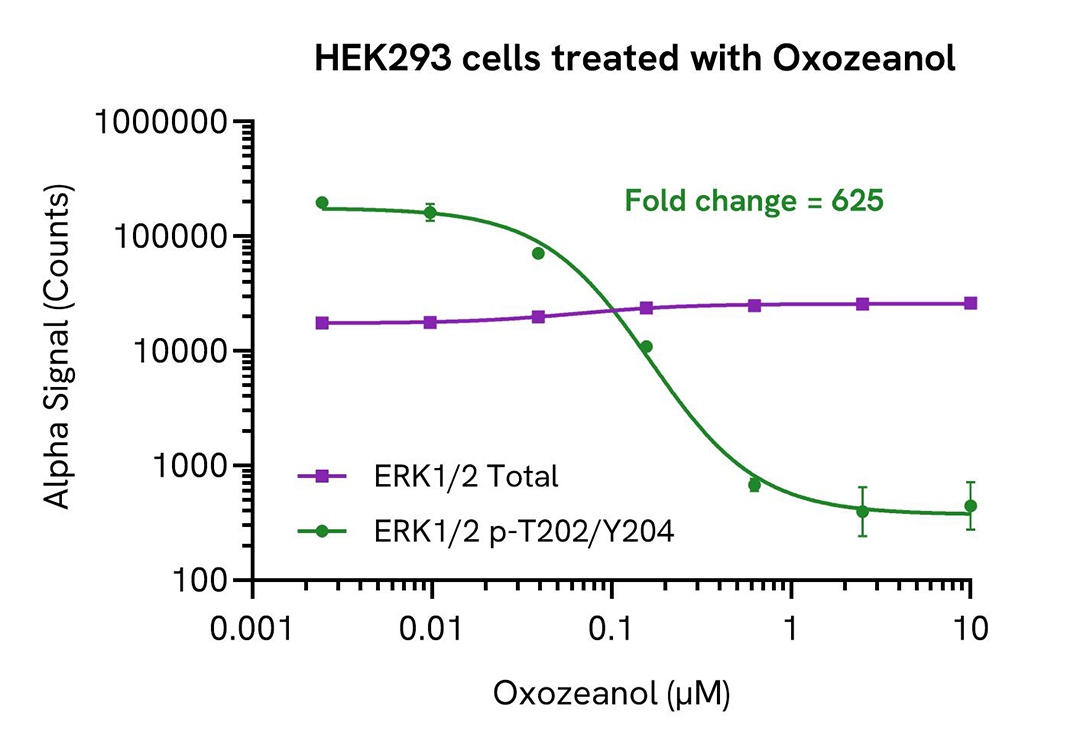
Decrease of Phospho ERK1/2 (Thr202/Tyr204) levels in AMG-510 treated cells
SW 1573 cells were seeded in a 96-well plate (40,000 cells/well) in complete medium, and incubated overnight at 37°C, 5% CO2. The cells were treated with increasing concentrations of AMG-510 for 1 hour.
After treatment, the cells were lysed with 100 µL of Lysis Buffer for 10 minutes at RT with shaking (350 rpm). ERK1/2 Phospho (Thr202/Tyr204) and Total levels were evaluated using respective AlphaLISA SureFire Ultra assays. For the detection step, 10 µL of cell lysate (approximately 4,000 cells) was transferred into a 384-well white OptiPlate, followed by 5 µL of Acceptor mix and incubated for 1 hour at RT. Finally, 5 µL of Donor mix was then added to each well and incubated for 1 hour at RT in the dark. The plate was read on an Envision using standard AlphaLISA settings.
As expected, AMG-510 triggered a dose-dependent decrease in the levels of Phospho ERK (Thr202/Tyr204) while Total ERK1/2 levels remained unchanged.
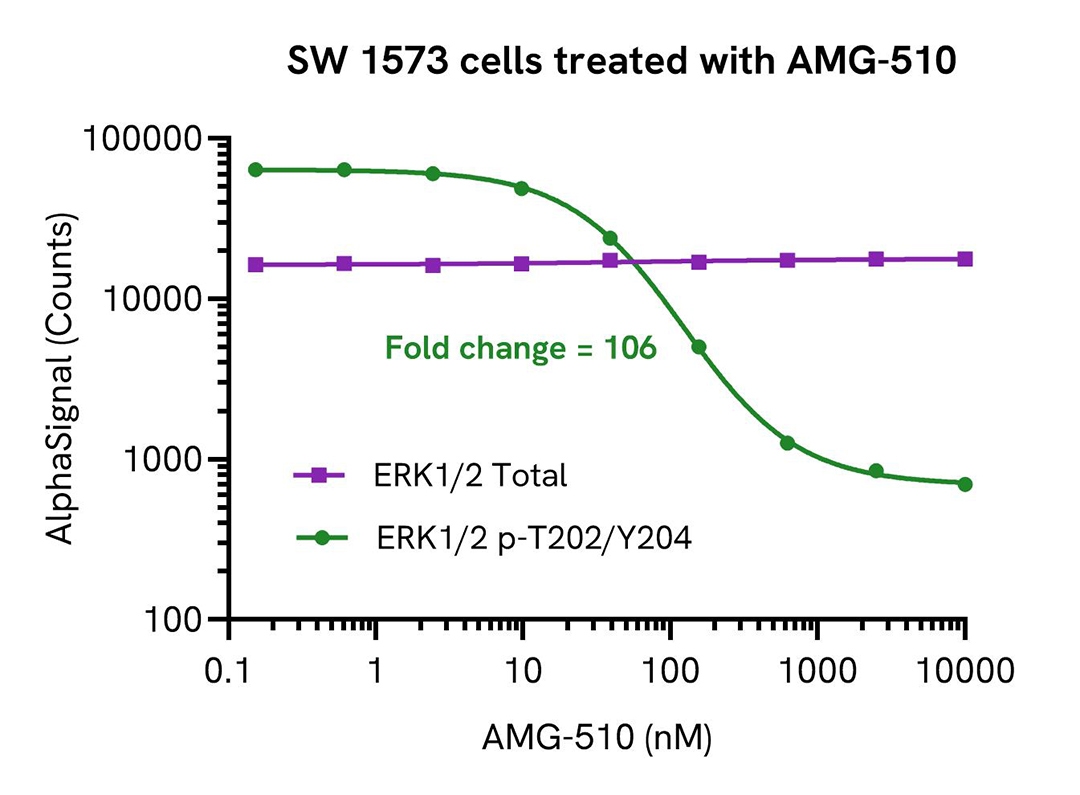
Specifications
| Application |
Cell Signaling
|
|---|---|
| Automation Compatible |
Yes
|
| Brand |
AlphaLISA SureFire Ultra
|
| Cellular or Signaling Pathway |
MAPK
|
| Detection Modality |
Alpha
|
| Lysis Buffer Compatibility |
Lysis Buffer
|
| Molecular Modification |
Phosphorylation
|
| Product Group |
Kit
|
| Sample Volume |
30 µL
|
| Shipping Conditions |
Shipped in Blue Ice
|
| Target |
ERK1/2
|
| Target Class |
Phosphoproteins
|
| Target Species |
Human
Mouse
|
| Technology |
Alpha
|
| Therapeutic Area |
Cardiovascular
Central Nervous System
Neuroinflammation
|
| Unit Size |
100 assay points
|
Video gallery


AlphaLISA SureFire Ultra Human and Mouse Phospho-ERK1/2 (Thr202/Tyr204) Detection Kit, 100 Assay Points


AlphaLISA SureFire Ultra Human and Mouse Phospho-ERK1/2 (Thr202/Tyr204) Detection Kit, 100 Assay Points


Citations
Resources
Are you looking for resources, click on the resource type to explore further.
This guide outlines further possible optimization of cellular and immunoassay parameters to ensure the best possible results are...
The definitive guide for setting up a successful AlphaLISA SureFire Ultra assay
Several biological processes are regulated by...
Discover Alpha SureFire® Ultra™ assays, the no-wash cellular kinase assays leveraging Revvity's exclusive bead-based technology...
The measurement of protein phosphorylation is a useful tool for measuring the modulation of receptor activation by both antibodies...
G protein coupled-receptors (GPCRs) are one of the most intensively studied drug targets, with up to one-third of all marketed...
Unlock the potential of bispecific antibodies (bsAbs) in cancer immunotherapy with this review, featuring no-wash detection...
Loading...


How can we help you?
We are here to answer your questions.






























